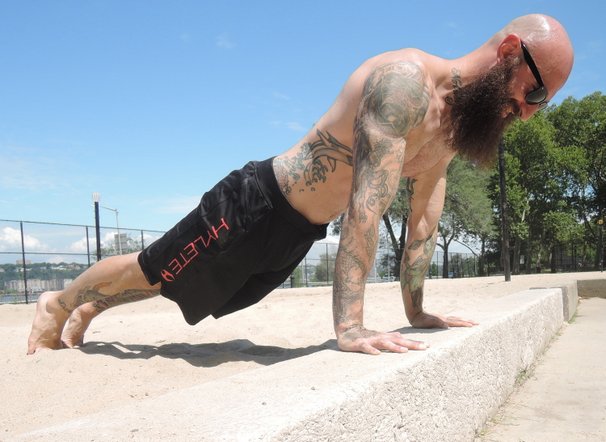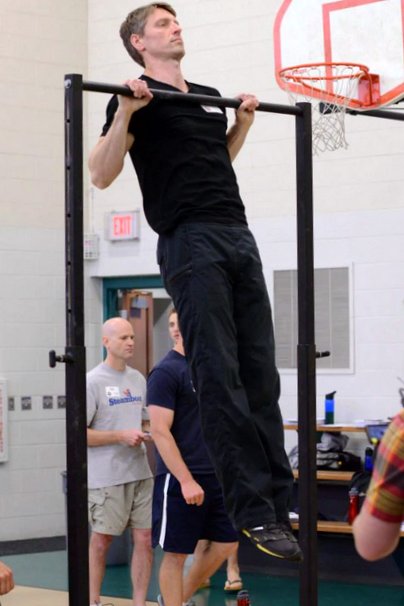
A lot of my personal training clients start out thinking that training faster means training better. But working out like The Flash won’t make you superhuman if you are bobbing your head for apples with your elbows flared out over your shoulders instead of actually doing push-ups. Poor form at a super-fast pace is not only allowing momentum to carry you through part of the range of motion, but it’s also potentially causing unnecessary strain on tendons and ligaments, as the muscles that should be doing the work aren’t activated properly.
My first rule for my clients is to focus on proper form. I created the phrase “AF3” which stands for Absolute Form Fit Function. The intention is to master the form, which improves fitness and ultimately, overall function. One antidote toward improper form is slowing down the rep speed. Let’s continue to look at the push-up as an example.
As you probably know, the push-up is essentially a traveling plank. It is a total body exercise and not just for building big pecs. Now do me a favor and go try an extremely slow push-up with full range of motion. Start in a plank with fully extended arms and lower down very gradually, touching your chest to the floor, then push back to fully extended arms.
You might have had some form breaks or even lacked strength to complete the rep. You should have definitely experienced the feeling of total body activation needed to maintain the straight body alignment in the absence of momentum. If you couldn’t do the full range-of-motion, consider modifying the exercise. For example, try placing your knees on the floor. This will shorten your body length (lever) so you will have to push less percentage of your bodyweight. Yes, the regression of an exercise can be an important part of progressing. It’s important to not let your ego deter you from modifications. You can often foster quicker progressions by perfecting “easier” versions of an exercise.
There are numerous ways you can manipulate your rep speed in order to develop better body control. The following is one example of a set of 7 push-ups stretched out over 2 minutes and 40 seconds.
Rep 1- 10 second rep (5 seconds down/negative and 5 seconds up/positive)
Rep 2- 20 second rep (10 seconds down/negative and 10 seconds up/ positive)
Rep 3- 30 second rep (15 seconds down/negative and 15 seconds up/positive)
Rep 4- 40 second rep (20 seconds down/negative and 20 seconds up /positive)
Rep 5- 30 second rep (15 seconds down/negative and 15 seconds up/positive)
Rep 6- 20 second rep (10 seconds down/negative and 10 seconds up positive)
Rep 7- 10 second rep (5 seconds down/negative and 5 seconds up/positive)
Notice how the set starts by climbing up the ladder in 10 second increments for each push-up from rep 1 (10 second rep) through rep 4 (40 second rep). Then at rep 5, it goes back down the ladder by decreasing the time in 10 second increments until you reach rep number 7 (10 second rep). The times listed aren’t absolute, so feel free to experiment with them. The important thing is to move evenly and controlled throughout the range-of-motion. Avoid fast jerky movements or hitting and holding positions.
To keep a solid pace, I recommend either using a stopwatch or a metronome (a device that musicians use to keep a specific tempo). Personally, I prefer the sound of the metronome. There are now free metronome apps available that you can download to your smartphone. Be sure to set the beats per minute to 60 (that equals one beat per second). It takes some concentration when counting to avoid rushing where you should be within a specific rep, which adds another layer and takes this challenge to the next level. It is mind over matter.
Though we’ve been using the push-up as our main example, remember that you can use this method with just about any exercise: pull-ups, squats (even pistols!), skin the cats…the list goes on.

Of course, you will move slowly if you only train slowly. So yes, performing fast reps is important. The point is to move fast well. In order to incorporate faster reps, you could use this structure by using the same 60 beats per minute with one set of 7 push-ups and adjusting the times as follows:
Rep 1- 2 second rep (1 seconds down/negative and 1 seconds up/positive)
Rep 2- 4 second rep (2 seconds down/negative and 2 seconds up positive)
Rep 3- 8 second rep (4 seconds down/negative and 4 seconds up/positive)
Rep 4- 16 second rep (8 seconds down/negative and 8 seconds up /positive)
Rep 5- 8 second rep (4 seconds down/negative and 4 seconds up/positive)
Rep 6- 4 second rep (2 seconds down/negative and 2 seconds up positive)
Rep 7- 2 second rep (1 seconds down/negative and 1 seconds up/positive)
Since the first rep and seventh rep are quick, you can even consider making them plyometric to build explosive power. Notice that shorter rep times will inherently eliminate some exercises. For example, it might not be the best idea to do a two second skin the cat.
Experiment with your rep speed but don’t let your ego get in the way. If you need to regress an exercise in order to maintain good quality of movement, then do so. Soon enough, you’ll gain the strength you desire to control any rep at any speed through it’s entire range-of-motion.
****
Benji Williford, PCC, RYT, CF-L1 is a Personal Fitness Trainer located out of Eau Claire, WI. Benji believes that, “A successful fitness program is based on positive dialogue between the mind and body.” He can be reached through his website: http://www.benjiwilliford.com, or by email: Benji@ChainReaction-Fitness.com.